We use cookies and other technologies to personalize your experience and collect analytics.
Annual Honesty Francesca Mollett
Francesca Mollett Annual Honesty
5 June – 19 July 2025
In these recent paintings by Francesca Mollett, feelings of disintegration and constellation are processed through surrogate image-stories about things coming apart then together, as part of something new. Her fractured surfaces appear as if made up of glances, faceted by time and the flickering of eye-lids. They pulsate with different modes of perception and cognition. Responding to the interactivities of light and space, movement and matter, Francesca forms a painterly language of reversals and multiplications; punctures, slips and transmissions.
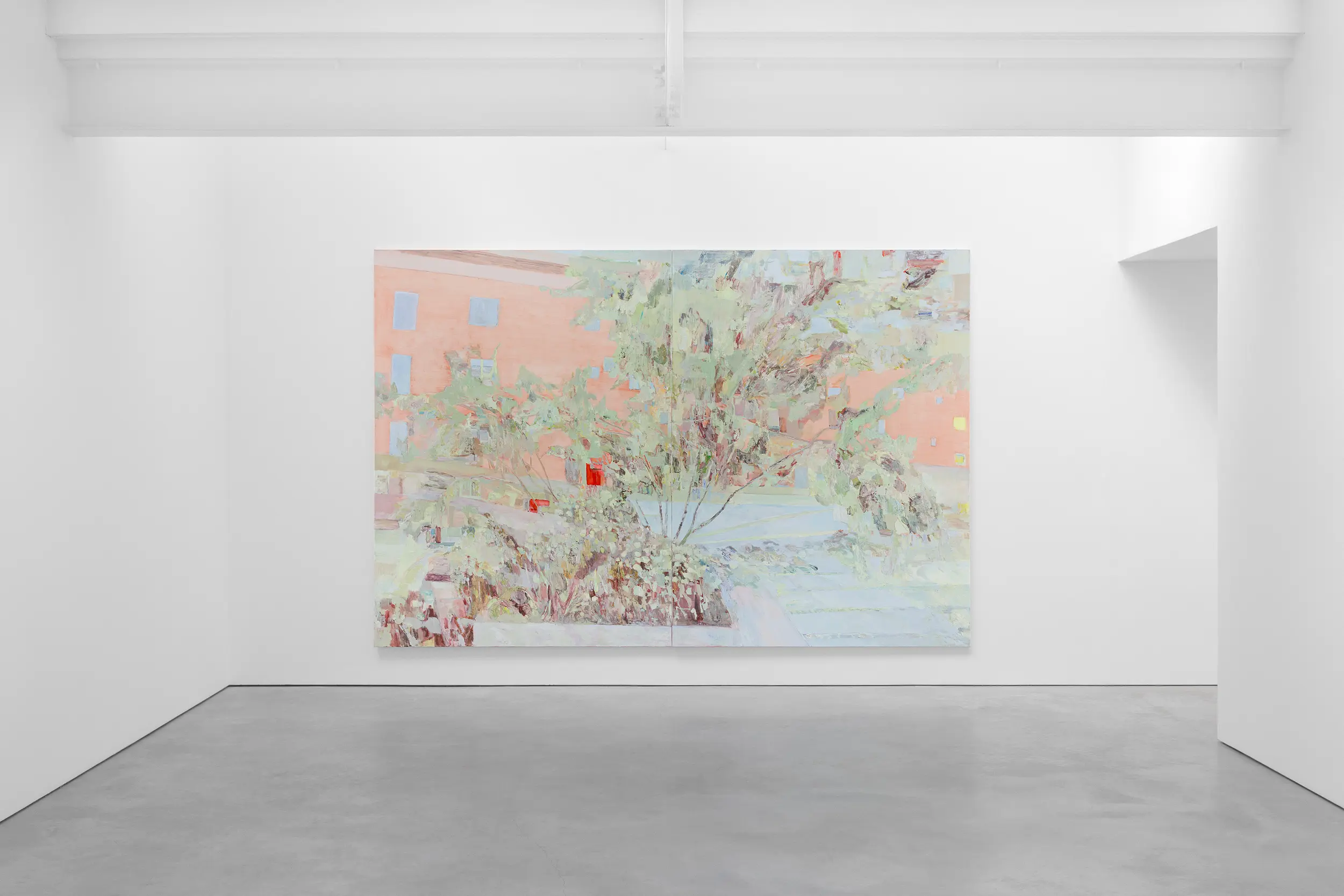
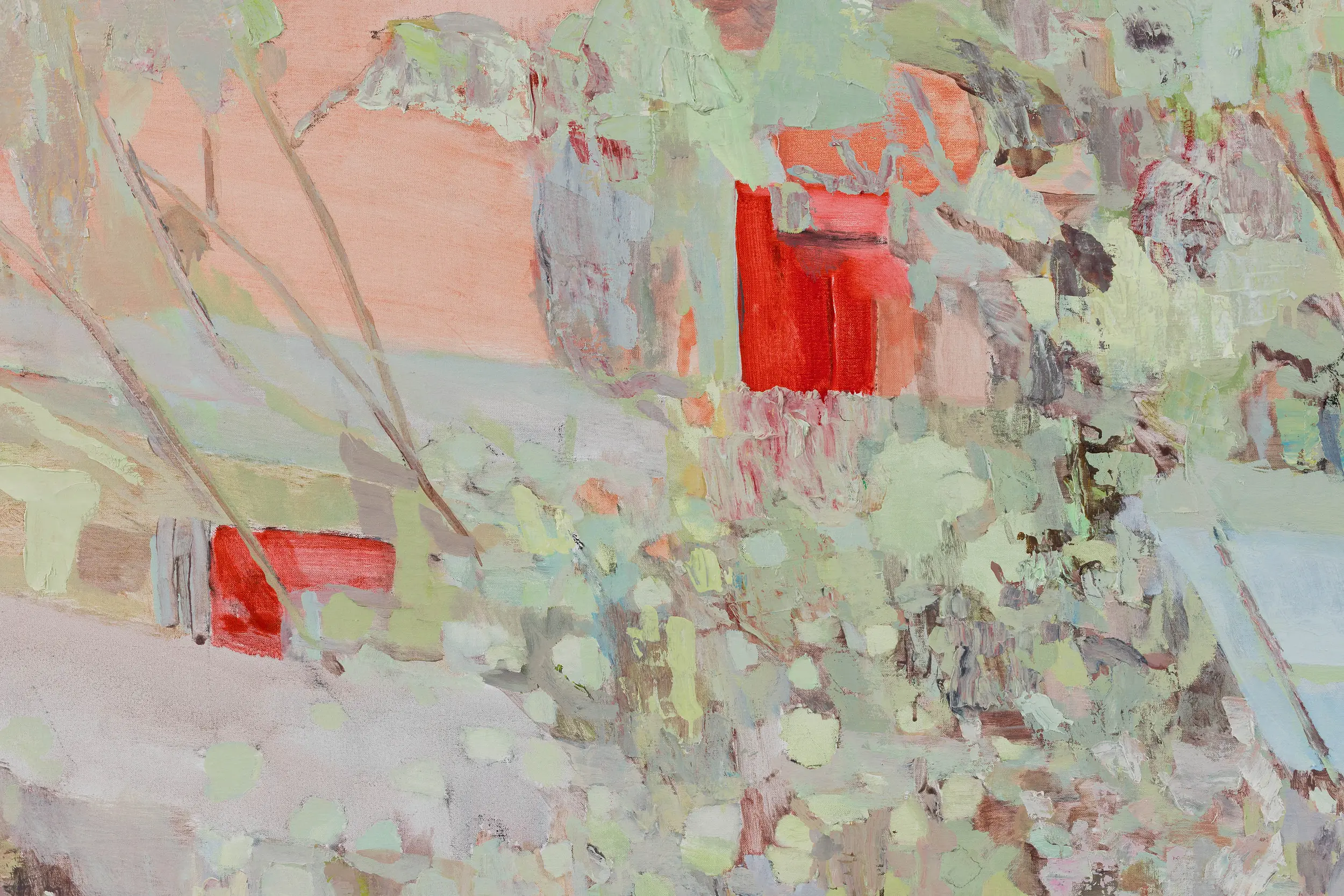
Although figures are rarely, if ever, shown, her paintings are concerned with the constitution of bodies. Shot through with the touch, traces and conflict between entities, they examine the ways that things appeal to one another, how they are drawn together and co-transform. In these works, Francesca attends, with precise subtlety and detail, to processes of infiltration and reflection – exploring their abilities to blur boundaries and erode distinctions, so that the paintings become complex mesh-like surface-structures of mirrors and splits, of recognition and estrangement.
‘There is something in emulation of the reflection and the mirror; it is the means whereby things scattered through the universe can answer one another’, writes Michel Foucault in ‘The Prose of the World’, describing the ability of illumination and reflection to form ties of likeness and exchange without contact; to impart and duplicate while collapsing distance. It is from this essay – about the operative functions of resemblance in the construction of Renaissance knowledge – that the painting Terrestrial Stars takes its title. According to Crollius (quoted by Foucault), ‘terrestrial stars’ are plants emulating stars, bouncing light up at the sky, while the stars in turn are ‘celestial plants’ projecting their particular qualities back down to the ground. Such mappings of similitudes and vibrancies, of the way that things do and might exist inside one another, is a driving force of Francesca’s new works.
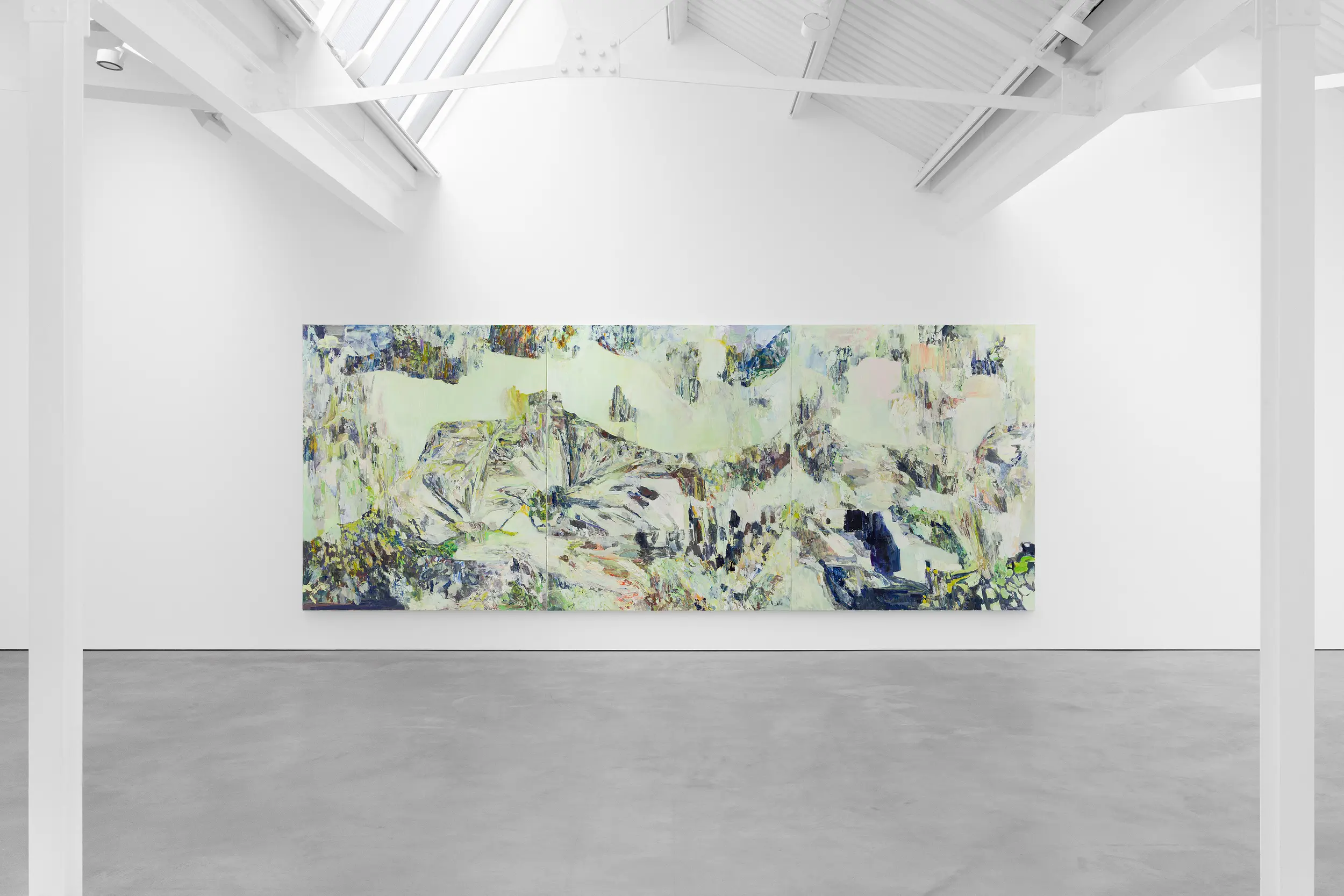
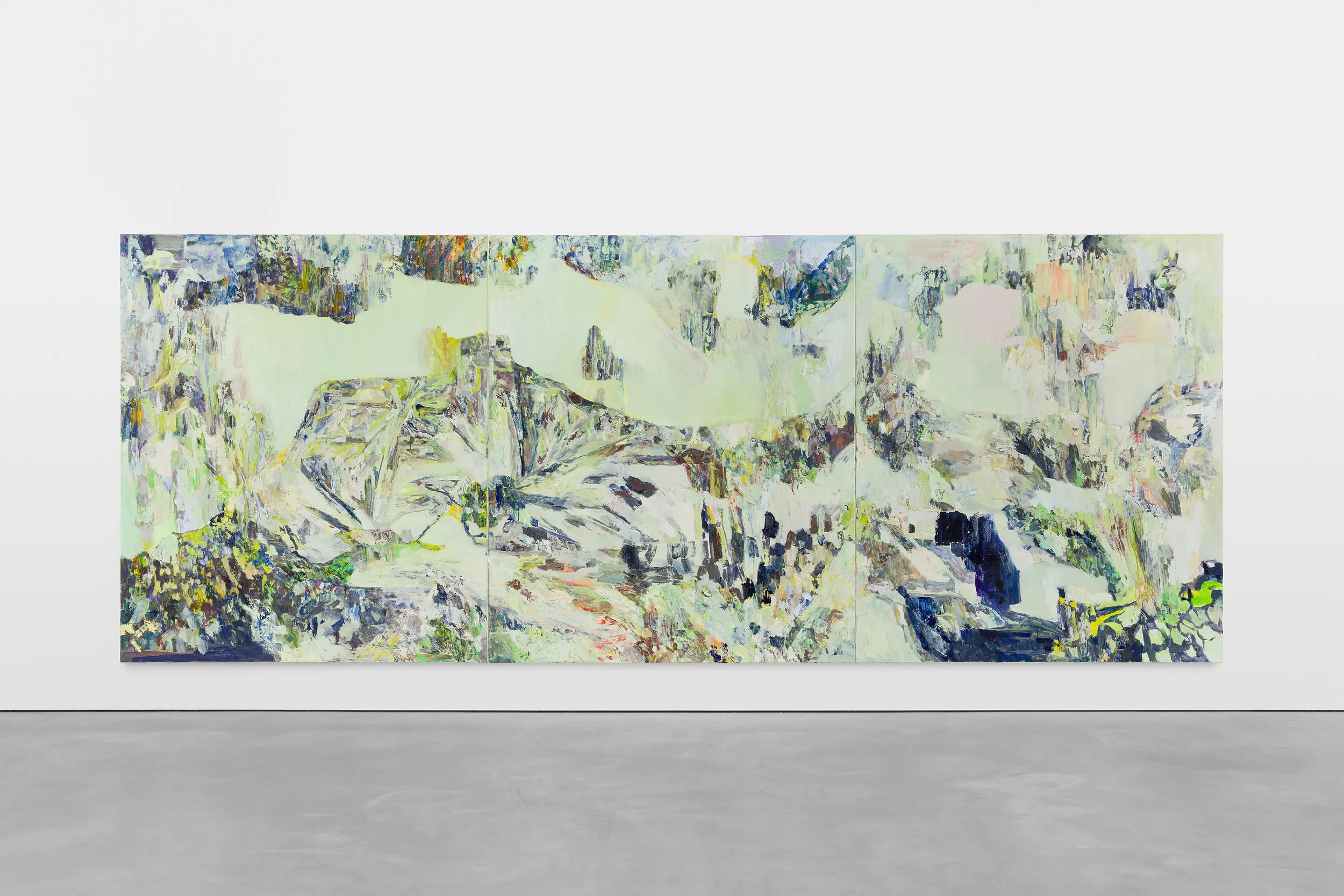
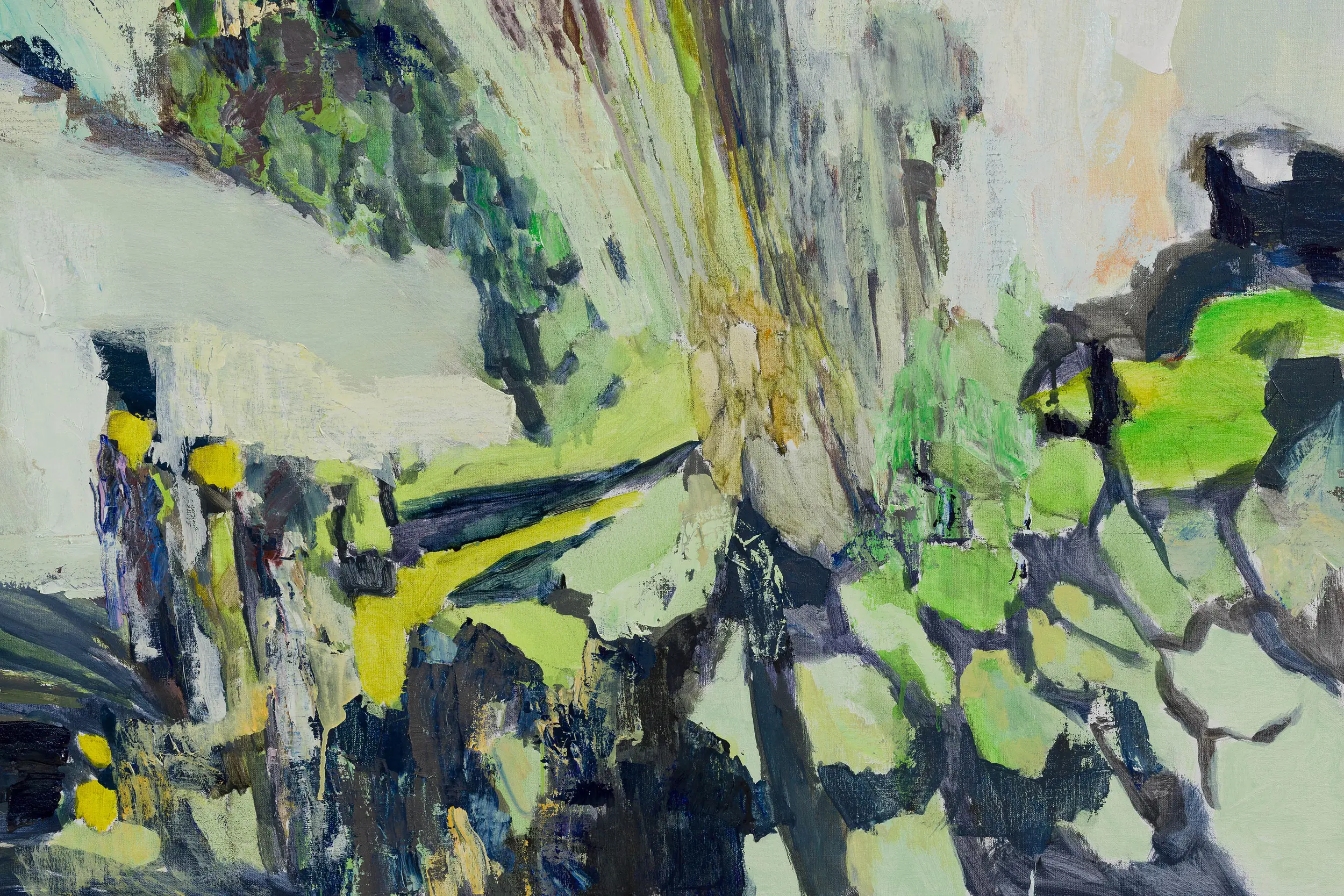
In Stave, inky shadows cast by luminous orb-like flower-heads join with stems to look like scattered crotchets: symbols of a single beat. A network of dark spidery strokes spread out across the surface of the canvas. In places they converge to become like the lines of a musical stave, threaded behind the notations. Elsewhere, the shadow lines overlay in disarray, complicating the spatial legibility of the scene. Across the ground, crinkly, shimmering greys create an optical mid-tone hum; an underfoot crunching between light and dark, softness and hardness, above and below.
A glimmering restlessness is created in Sous-bois, drawn from the crossover between two sources of light – the bulbs of street lamps and the dying daylight at dusk – and the particular shades of green that they generate as they fall on the foliage of a plant, weaving through the bands of a mint-painted fence. Meaning ‘under the trees’ or ‘undergrowth’, Sous-bois is a title that was given to paintings by Cezanne and Van Gogh and has come to refer to a sub-genre of Impressionist painting made in-situ within woodland interiors. Depicting scenes encapsulated within nature, these ‘landscapes’ became vertical, close and intimate. In Francesca’s Sous-bois, vegetative growth and death spill through the slats of a partition fence and accumulate in a dense wreath-like channel on the ground. Despite the earthward aspect, this painting is filled with sky, reflected in the surfaces of thing looked down upon, so that the tangled leaves and flowers become mirrors or lights or holes.
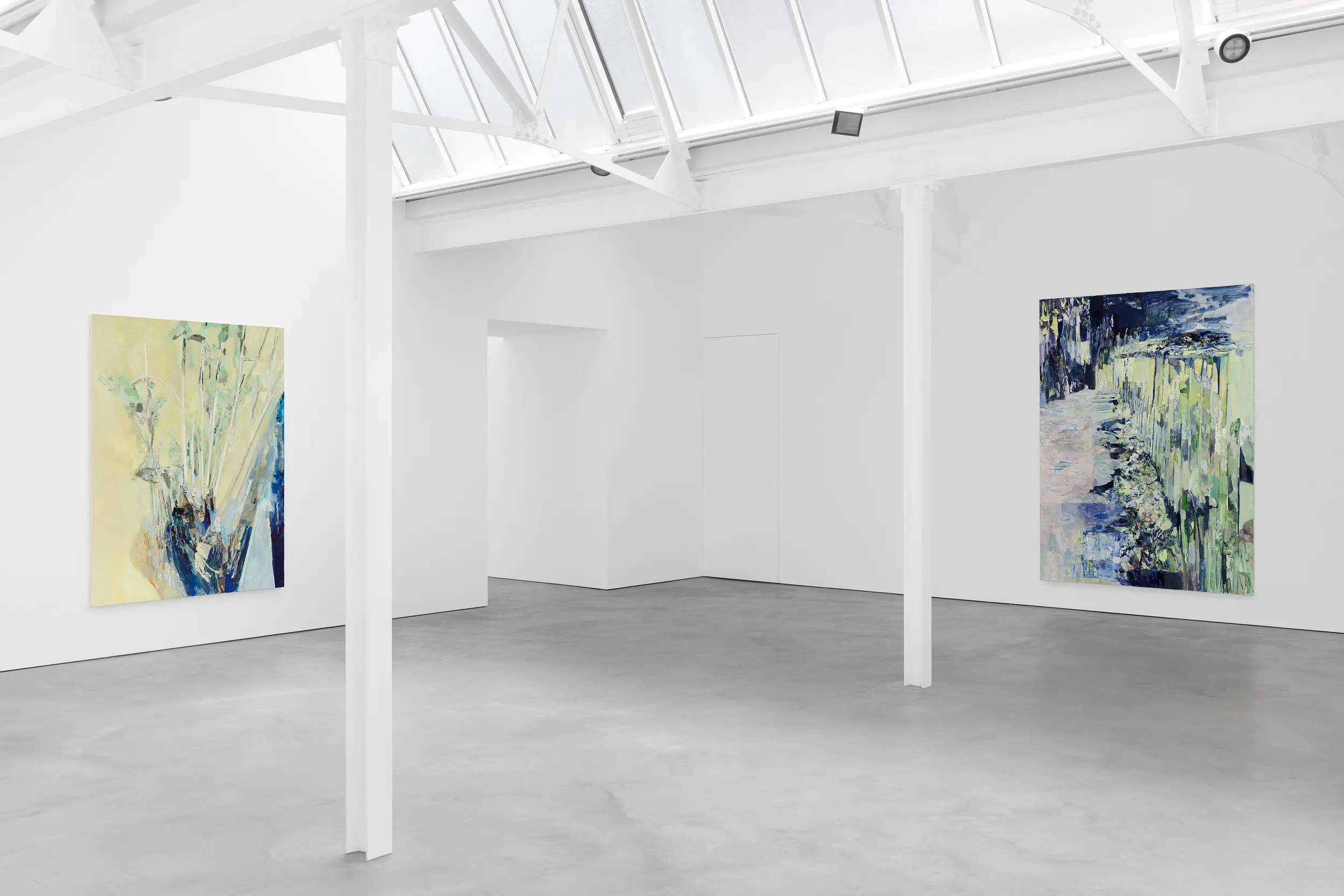
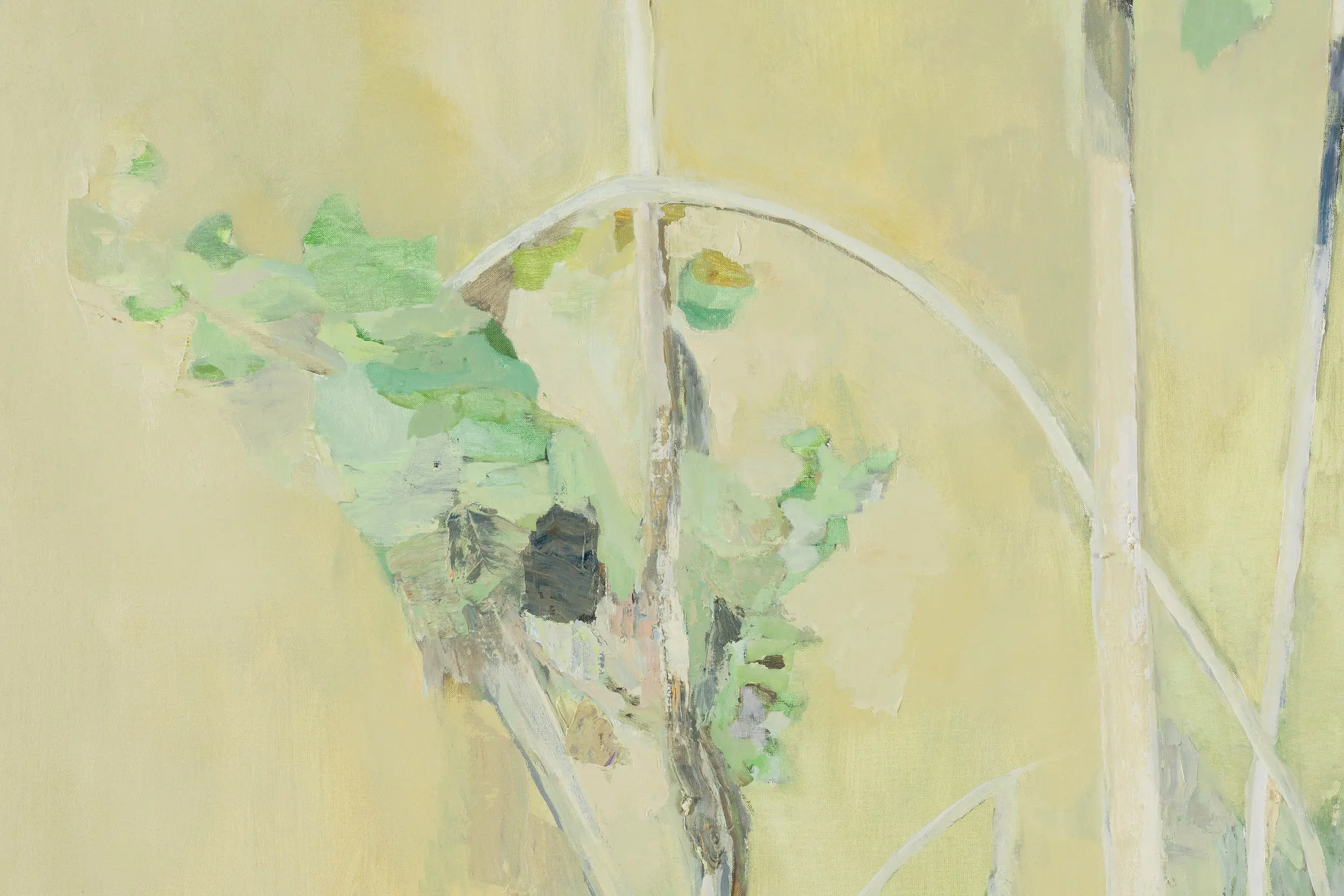
Francesca’s paintings are often organised by things that act as holes in the composition. Elements that rupture, but also offer new ways to enter and interpret, the image. The annual honesty plant, after which the exhibition is named, has flat, moon-shaped seed pods that are translucent – creating see-through pockets. Also known as the ‘money plant’, it reveals, truthfully, all that it holds. Once the pods fall away, circular membranes remain, tracing an outline of a hole or window. The plant’s cyclical transition between outline, hole and wholeness – conceived as periodic honesty – is offered here as a way of thinking about the process of painting. As a turning toward and then away from a truth or essence. As a way to get closer to something by moving away from what it was first thought to be. As a continual looping between resemblance and absence and presence.
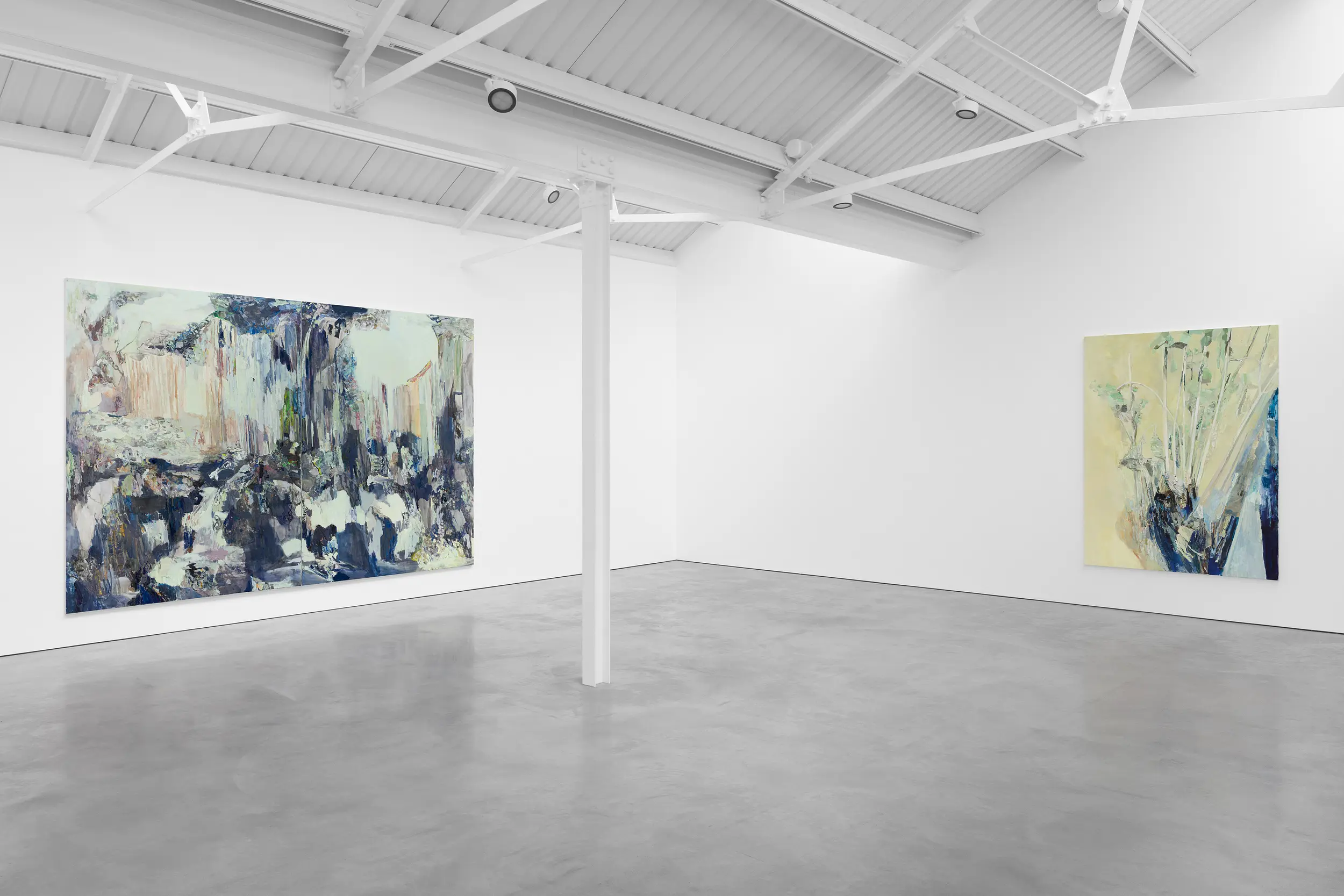
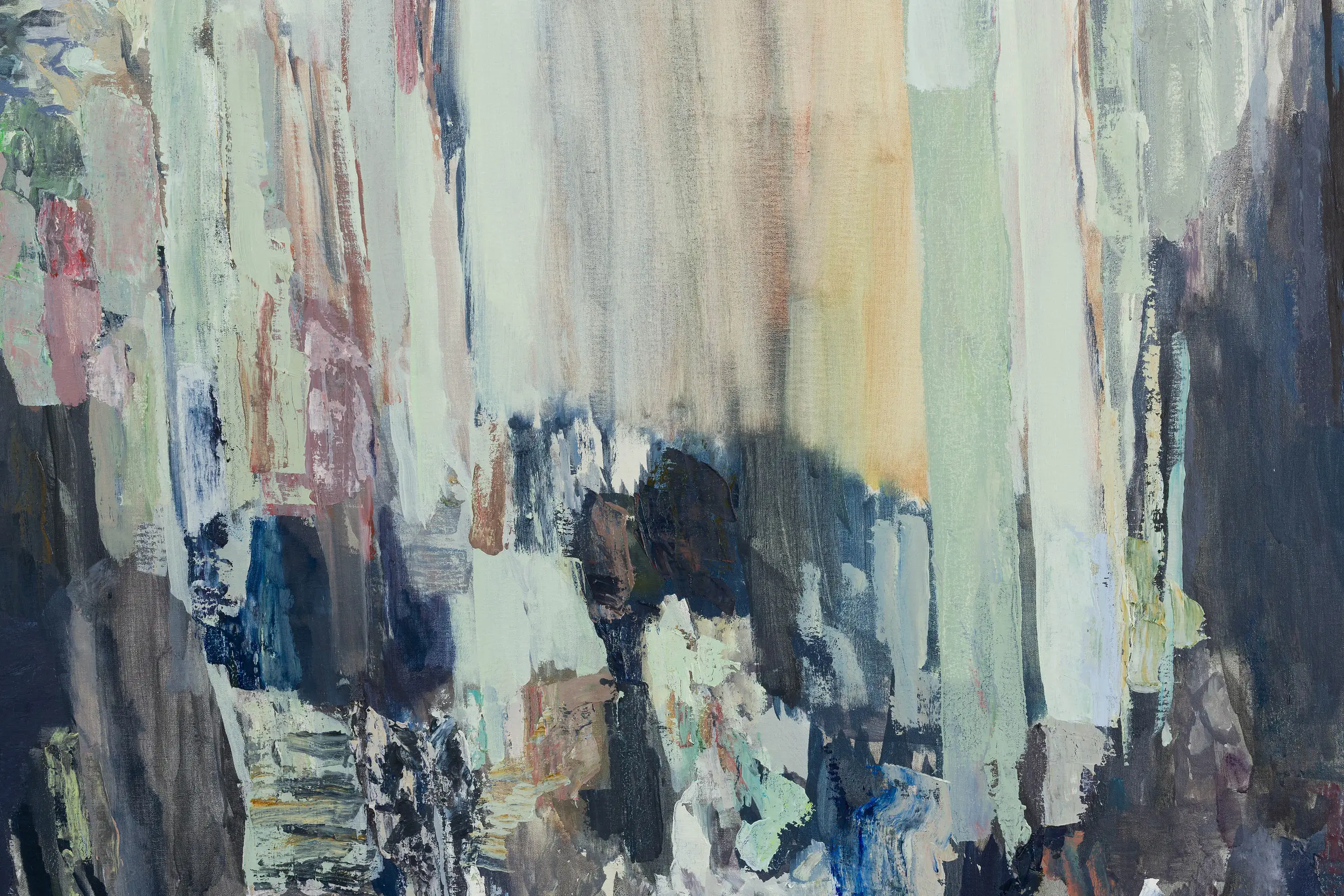
Part of Francesca’s process is creating a balance of context and detail – of giving what is needed compositionally for something to operate or ignite. Afterall, to unsettle, something first needs to be settled. Paint becomes a live matter that she uses to lay down her image and find within in it an activating essence for self-destabilisation. A problem quality, a latent energy, ready to turn or move, through which the painting can emerge as something new. Her compositions begin as momentary frames that slip over time as the image operates in and through the painting. As she works, Francesca oscillates away from and back to her original visual catalyst; moving between a focused search for a substitute for this dynamic quality in paint, and allowing it the freedom to move and generate. Echoing elemental processes of reconfiguration, the paintings open up the possibilities of her subjects through abstraction. By taking them to pieces and piecing them together she finds new chains of connection, new patterns of becoming, so that the final paintings reveal a collaged temporality, containing traces of and pathways to previous and potential states.
– Bryony Bodimeade

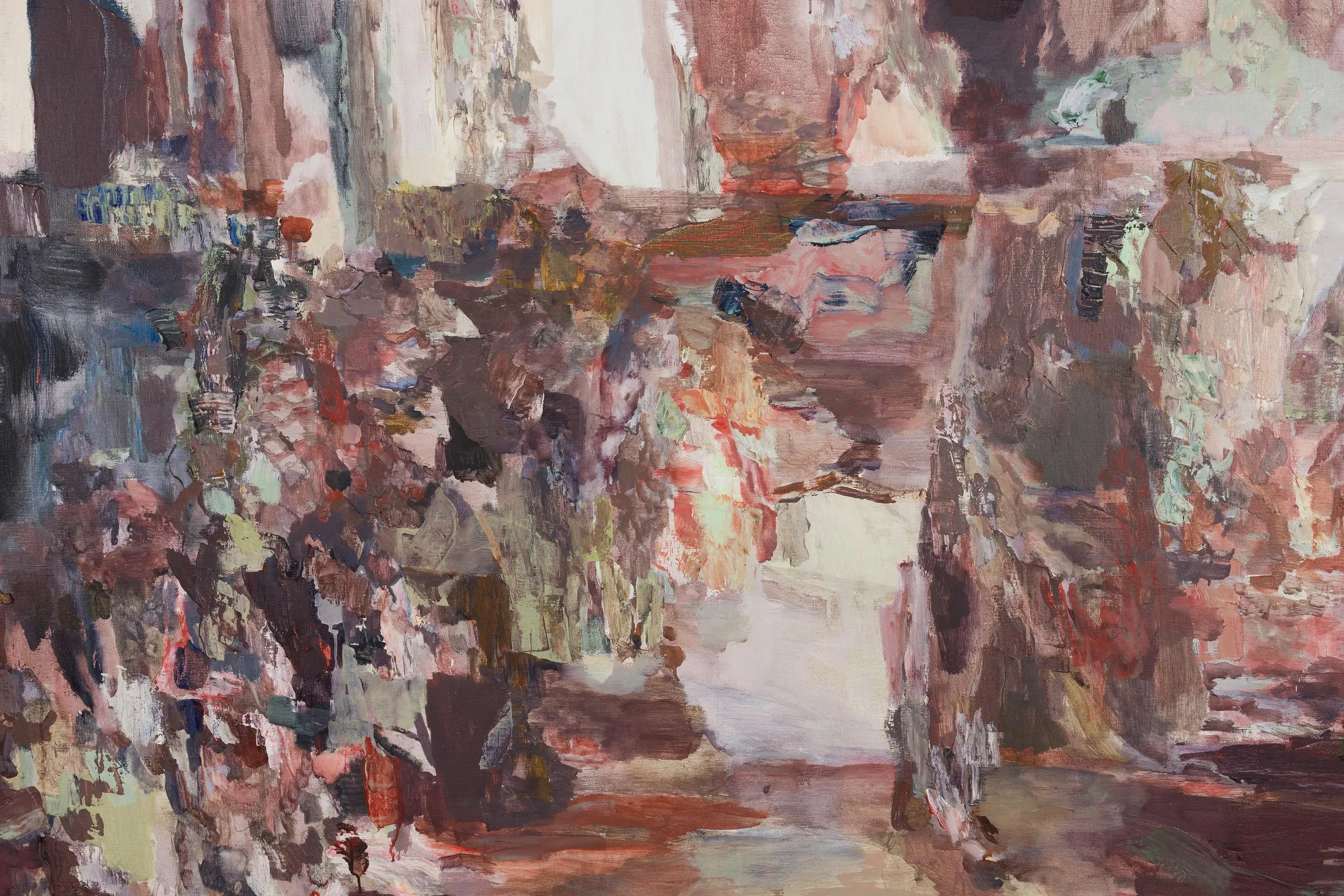
Francesca Mollett was born in 1991 in Bristol, UK, and she lives and works in London. She received her MA in Painting from the Royal College of Art, London in 2020, having previously studied at the Royal Drawing School and Wimbledon College of Art, London. Recent solo exhibitions include Elsewhere, Warehouse Dallas, TX (US), 2025; Corso, GRIMM, New York, NY (US), 2024; Noon, Pond Society, Shanghai (CN); Halves, GRIMM, Amsterdam (NL) and Low Sun, Micki Meng, San Francisco, CA (US), 2023; The Moth in the Moss, Taymour Grahne Projects, London, 2022; Spiral Walking, Baert Gallery, Los Angeles, CA (US), 2022 and Wild Shade, Informality Gallery, London, 2021.
Her work has been included in such group exhibitions as A Room Hung With Thoughts: British Painting Now, curated by Tom Morton, Green Family Art Foundation, Dallas, TX (US); New British Abstraction, CICA, Vancouver (CA); Considering Female Abstractions, Green Family Art Foundation, Dallas, TX (US), 2023; Sabrina, curated by Russell Tovey, Sim Smith, London; The Kingfisher’s Wing, curated by Tom Morton, GRIMM, New York, NY (US), 2022; New Romantics, The Artist Room at Lee Eugean Gallery, Seoul (KR); Down in Albion, L.U.P.O. Lorenzelli Projects, Milan, (IT), 2022; and London Grads Now, Saatchi Gallery, London, 2020. Mollett’s work is included in collections such as the Comico Art Museum Yufuin, Oita Japan; David and Indrė Roberts Collection, London; the Green Family Art Foundation, Dallas, TX; He Art Museum, Foshan, China; Institute of Contemporary Art, Miami, FL; K11 Art Foundation, Hong Kong; Kröller-Müller Museum, Otterlo, Netherlands; Kunstmuseum, The Hague, Netherlands; Olivia Foundation, Mexico City, Mexico; Pond Society, Shanghai, China; the Rachofsky Collection, Dallas, TX, US; Sainsbury Centre, Norwich, and The University of Oxford, St Hilda’s College Art Collection, Oxford.
Press Release

In these recent paintings by Francesca Mollett, feelings of disintegration and constellation are processed through surrogate image-stories about things coming apart then together, as part of something new. Her fractured surfaces appear as if made up of glances, faceted by time and the flickering of eye-lids. They pulsate with different modes of perception and cognition. Responding to the interactivities of light and space, movement and matter, Francesca forms a painterly language of reversals and multiplications; punctures, slips and transmissions.
Although figures are rarely, if ever, shown, her paintings are concerned with the constitution of bodies. Shot through with the touch, traces and conflict between entities, they examine the ways that things appeal to one another, how they are drawn together and co-transform. In these works, Francesca attends, with precise subtlety and detail, to processes of infiltration and reflection – exploring their abilities to blur boundaries and erode distinctions, so that the paintings become complex mesh-like surface-structures of mirrors and splits, of recognition and estrangement.
‘There is something in emulation of the reflection and the mirror; it is the means whereby things scattered through the universe can answer one another’, writes Michel Foucault in ‘The Prose of the World’, describing the ability of illumination and reflection to form ties of likeness and exchange without contact; to impart and duplicate while collapsing distance. It is from this essay – about the operative functions of resemblance in the construction of Renaissance knowledge – that the painting Terrestrial Stars takes its title. According to Crollius (quoted by Foucault), ‘terrestrial stars’ are plants emulating stars, bouncing light up at the sky, while the stars in turn are ‘celestial plants’ projecting their particular qualities back down to the ground. Such mappings of similitudes and vibrancies, of the way that things do and might exist inside one another, is a driving force of Francesca’s new works.
In Stave, inky shadows cast by luminous orb-like flower-heads join with stems to look like scattered crotchets: symbols of a single beat. A network of dark spidery strokes spread out across the surface of the canvas. In places they converge to become like the lines of a musical stave, threaded behind the notations. Elsewhere, the shadow lines overlay in disarray, complicating the spatial legibility of the scene. Across the ground, crinkly, shimmering greys create an optical mid-tone hum; an underfoot crunching between light and dark, softness and hardness, above and below.
A glimmering restlessness is created in Sous-bois, drawn from the crossover between two sources of light – the bulbs of street lamps and the dying daylight at dusk – and the particular shades of green that they generate as they fall on the foliage of a plant, weaving through the bands of a mint-painted fence. Meaning ‘under the trees’ or ‘undergrowth’, Sous-bois is a title that was given to paintings by Cezanne and Van Gogh and has come to refer to a sub-genre of Impressionist painting made in-situ within woodland interiors. Depicting scenes encapsulated within nature, these ‘landscapes’ became vertical, close and intimate. In Francesca’s Sous-bois, vegetative growth and death spill through the slats of a partition fence and accumulate in a dense wreath-like channel on the ground. Despite the earthward aspect, this painting is filled with sky, reflected in the surfaces of thing looked down upon, so that the tangled leaves and flowers become mirrors or lights or holes.
Francesca’s paintings are often organised by things that act as holes in the composition. Elements that rupture, but also offer new ways to enter and interpret, the image. The annual honesty plant, after which the exhibition is named, has flat, moon-shaped seed pods that are translucent – creating see-through pockets. Also known as the ‘money plant’, it reveals, truthfully, all that it holds. Once the pods fall away, circular membranes remain, tracing an outline of a hole or window. The plant’s cyclical transition between outline, hole and wholeness – conceived as periodic honesty – is offered here as a way of thinking about the process of painting. As a turning toward and then away from a truth or essence. As a way to get closer to something by moving away from what it was first thought to be. As a continual looping between resemblance and absence and presence.
Part of Francesca’s process is creating a balance of context and detail – of giving what is needed compositionally for something to operate or ignite. Afterall, to unsettle, something first needs to be settled. Paint becomes a live matter that she uses to lay down her image and find within in it an activating essence for self-destabilisation. A problem quality, a latent energy, ready to turn or move, through which the painting can emerge as something new. Her compositions begin as momentary frames that slip over time as the image operates in and through the painting. As she works, Francesca oscillates away from and back to her original visual catalyst; moving between a focused search for a substitute for this dynamic quality in paint, and allowing it the freedom to move and generate. Echoing elemental processes of reconfiguration, the paintings open up the possibilities of her subjects through abstraction. By taking them to pieces and piecing them together she finds new chains of connection, new patterns of becoming, so that the final paintings reveal a collaged temporality, containing traces of and pathways to previous and potential states.
– Bryony Bodimeade
Francesca Mollett was born in 1991 in Bristol, UK, and she lives and works in London. She received her MA in Painting from the Royal College of Art, London in 2020, having previously studied at the Royal Drawing School and Wimbledon College of Art, London. Recent solo exhibitions include Elsewhere, Warehouse Dallas, TX (US), 2025; Corso, GRIMM, New York, NY (US), 2024; Noon, Pond Society, Shanghai (CN); Halves, GRIMM, Amsterdam (NL) and Low Sun, Micki Meng, San Francisco, CA (US), 2023; The Moth in the Moss, Taymour Grahne Projects, London, 2022; Spiral Walking, Baert Gallery, Los Angeles, CA (US), 2022 and Wild Shade, Informality Gallery, London, 2021.
Her work has been included in such group exhibitions as A Room Hung With Thoughts: British Painting Now, curated by Tom Morton, Green Family Art Foundation, Dallas, TX (US); New British Abstraction, CICA, Vancouver (CA); Considering Female Abstractions, Green Family Art Foundation, Dallas, TX (US), 2023; Sabrina, curated by Russell Tovey, Sim Smith, London; The Kingfisher’s Wing, curated by Tom Morton, GRIMM, New York, NY (US), 2022; New Romantics, The Artist Room at Lee Eugean Gallery, Seoul (KR); Down in Albion, L.U.P.O. Lorenzelli Projects, Milan, (IT), 2022; and London Grads Now, Saatchi Gallery, London, 2020. Mollett’s work is included in collections such as the Comico Art Museum Yufuin, Oita Japan; David and Indrė Roberts Collection, London; the Green Family Art Foundation, Dallas, TX; He Art Museum, Foshan, China; Institute of Contemporary Art, Miami, FL; K11 Art Foundation, Hong Kong; Kröller-Müller Museum, Otterlo, Netherlands; Kunstmuseum, The Hague, Netherlands; Olivia Foundation, Mexico City, Mexico; Pond Society, Shanghai, China; the Rachofsky Collection, Dallas, TX, US; Sainsbury Centre, Norwich, and The University of Oxford, St Hilda’s College Art Collection, Oxford.
For more information, please contact Pascale de Graaf (pascale@modernart.net).